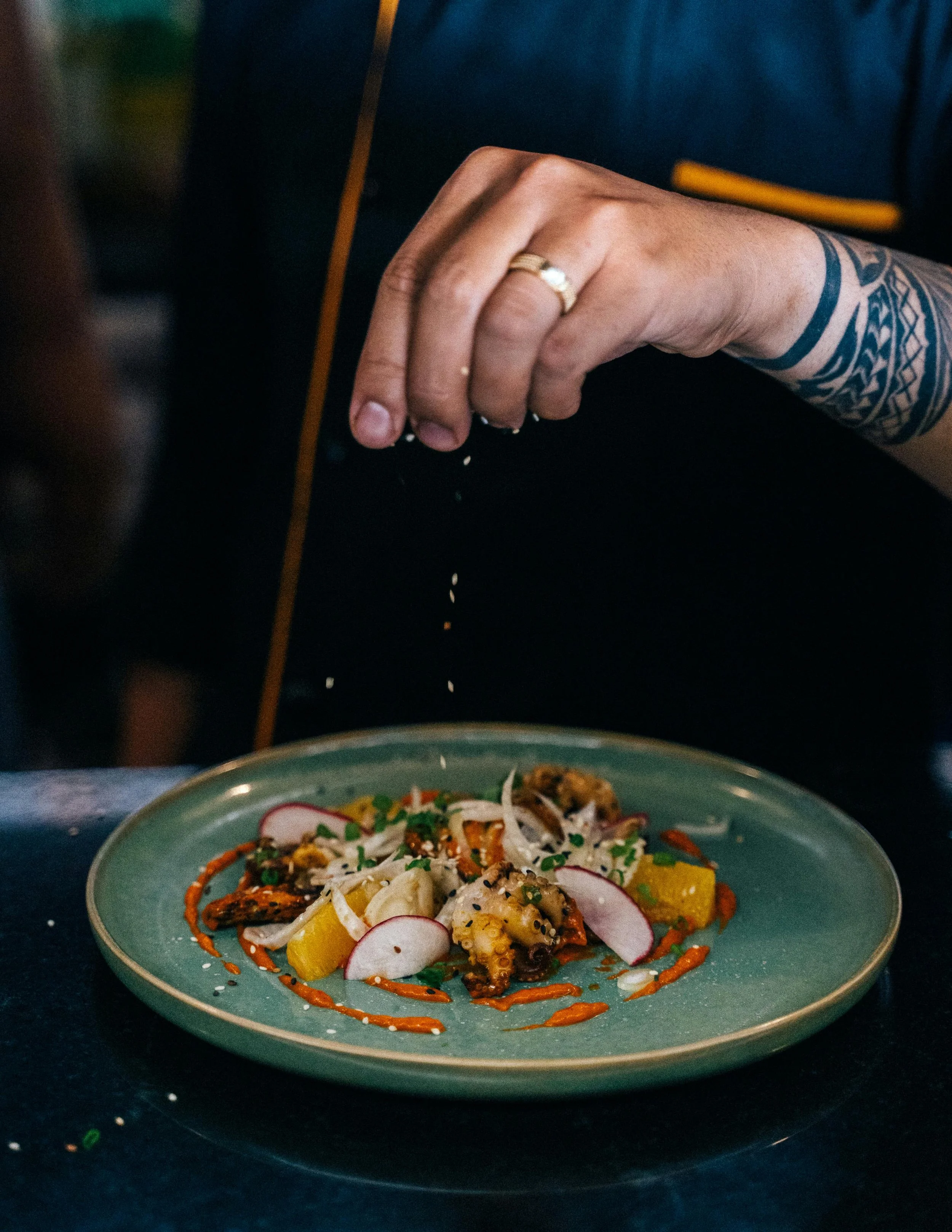RESTAURANT MARKETING THAT ACTUALLY DRIVES REVENUE (NOT JUST TRAFFIC)
Most restaurant marketing advice focuses on getting more people through the door. But what if you're already busy? What if your real challenge isn't traffic—it's building the kind of customer loyalty that drives sustainable revenue growth?
The restaurant industry has a dirty secret: 80% of new restaurants fail within five years, and it's rarely because they can't cook. It's because they treat marketing as a series of promotional tactics rather than a strategic system for building lasting relationships with their ideal customers.
The restaurants that thrive—the ones that weather economic downturns, survive staffing challenges, and command premium prices—understand that sustainable success comes from marketing that builds brand loyalty, not just foot traffic.
THE FATAL FLAW IN MOST RESTAURANT MARKETING
Walk down any main street and you'll see the same restaurant marketing playbook everywhere: discount deals, happy hour specials, social media posts about daily specials, and Groupon promotions. These tactics might fill seats temporarily, but they're building a customer base that only shows up for deals.
The problem with discount-driven marketing:
It attracts price-sensitive customers who won't return at full price
It trains customers to expect deals, eroding profit margins
It positions your restaurant as interchangeable with competitors
It creates feast-or-famine revenue cycles based on promotion schedules
Meanwhile, the restaurants that build sustainable businesses focus their marketing on a completely different goal: attracting customers who value what makes them unique.
WHAT SUCCESSFUL RESTAURANT MARKETING ACTUALLY LOOKS LIKE
The most profitable restaurants don't just market their food—they market their entire experience and philosophy. They understand that people don't just choose restaurants based on cuisine; they choose based on how a restaurant makes them feel and what it says about them.
Consider the difference between these two approaches:
Traditional Restaurant Marketing: "Try our new appetizer special! Half price this week only. Great food at great prices!"
Experience-Driven Restaurant Marketing: "Every ingredient tells a story. From our partnerships with local farms to our scratch-made approach, discover why our guests call us their 'home away from home.'"
The first approach competes on price and convenience. The second builds emotional connection and brand loyalty.
THE 5 PILLARS OF REVENUE-DRIVING RESTAURANT MARKETING
After working with numerous hospitality businesses, we've identified five essential strategies that separate thriving restaurants from struggling ones:
1. Define Your Restaurant's Unique Experience
Before you can market effectively, you need to be crystal clear about what experience you're actually selling. This goes far beyond your menu.
Key questions to answer:
What feeling do customers have when they leave your restaurant?
What story does your restaurant tell about food, community, or lifestyle?
How is the experience at your restaurant different from any other restaurant?
What values does your restaurant represent?
Case Study Insight: Nolabelle Kitchen + Bar in Minnesota didn't just market "upscale casual dining." They marketed their commitment to "real food from scratch using local ingredients" and their connection to Southern Minnesota's farming heritage. This clear positioning attracted customers who valued authenticity and quality over convenience and price.
2. Build an Email List That Actually Engages
Most restaurants collect emails but few use them strategically. Your email list should be your most valuable marketing asset—a direct line to customers who've already experienced what you offer.
Effective restaurant email strategies:
Share the stories behind your dishes and ingredients
Highlight your team members and their expertise
Offer exclusive access to new menu items (not just discounts)
Provide behind-the-scenes content that reinforces your brand story
Create anticipation around seasonal changes and special events
Real Results: Nolabelle achieved a 45% email open rate—more than double the restaurant industry average of 22%—by focusing on storytelling and brand reinforcement rather than promotional content.
3. Leverage Social Proof and Community Connection
People trust recommendations from others more than any advertising you can create. Smart restaurant marketing amplifies these authentic endorsements.
Strategies that work:
Feature customer stories and testimonials that highlight the experience, not just the food
Partner with local businesses and community organizations
Share user-generated content that shows your restaurant as part of customers' lives
Build relationships with local food writers and influencers who align with your brand
Create shareable moments within your restaurant experience
4. Optimize Your Digital Presence for Local Discovery
Most of your customers will discover you online before they visit. Your digital presence needs to accurately represent your actual restaurant experience.
Essential local marketing elements:
Google Business Profile optimized with professional photos and current information
Website that showcases your atmosphere and philosophy, not just your menu
Consistent brand messaging across all online platforms
Online reviews that reflect your target customer experience
Local SEO optimization for location-based searches
5. Create Marketing That Mirrors Your Service Quality
Your marketing should preview the experience customers will receive. If your service is warm and personal, your marketing should be warm and personal. If your restaurant is sophisticated and refined, your marketing materials should reflect that sophistication.
Brand-marketing alignment checklist:
Do your marketing materials match the quality of your actual restaurant?
Does your online personality reflect your in-person service style?
Would your ideal customer recognize your brand across all touchpoints?
Does your marketing attract the same type of customers you love serving?
CASE STUDY: HOW BRAND-ALIGNED MARKETING DRIVES GROWTH
Nolabelle Kitchen + Bar exemplifies how focusing on experience rather than deals creates sustainable growth. Instead of competing with chain restaurants on price and convenience, they built their marketing around their authentic farm-to-table story.
Their Strategic Approach:
Brand Foundation: Positioned around "real food from scratch" using local ingredients
Target Audience: Customers who value authenticity and quality over speed and price
Marketing Focus: Storytelling about local farmers, seasonal ingredients, and culinary craftsmanship
Community Connection: Deep ties to Southern Minnesota's agricultural heritage
The Results:
Built a "cult-like following" that extends far beyond their local market
Achieved email open rates of 45% (vs. industry average of 22%)
Maintained premium pricing despite competitive pressure
Generated significant word-of-mouth growth from loyal customers
Created a sustainable business model that doesn't rely on discounting
The Key Insight: When marketing authentically reflects what makes your restaurant special, it attracts customers who become genuine advocates rather than deal-seekers.
YOUR RESTAURANT MARKETING ACTION PLAN
Ready to shift from traffic-focused to revenue-focused marketing? Here's how to get started:
Week 1: Define Your Unique Experience
Identify what truly differentiates your restaurant beyond food
Survey current customers about why they choose you over competitors
Document the specific experience and values your restaurant represents
Create a clear brand positioning statement
Week 2: Audit Your Current Marketing
Review all marketing materials for consistency with your actual experience
Analyze your customer base: Are you attracting your ideal customers?
Assess your email marketing: Is it building relationships or just pushing deals?
Check your online presence: Does it accurately represent your restaurant?
Week 3-4: Align Your Marketing with Your Experience
Rewrite marketing messages to reflect your unique positioning
Update social media content to showcase your brand story
Revise email marketing to focus on relationship-building
Refresh website content to emphasize experience over just menu
Month 2 and Beyond: Build and Measure
Implement consistent brand-focused marketing across all channels
Track customer lifetime value and repeat visit rates
Monitor brand perception and customer feedback
Refine your approach based on results
THE LONG-TERM ADVANTAGE
Restaurants that build their marketing around authentic brand experiences rather than promotional tactics create several competitive advantages:
Sustainable Customer Base: Customers who connect with your brand continue visiting even when deals aren't available.
Premium Pricing Power: Strong brand loyalty allows you to maintain higher prices because customers value the unique experience.
Word-of-Mouth Growth: Customers who love your brand become advocates who actively recommend you to others.
Staff Clarity and Confidence: When marketing accurately reflects your restaurant's values, staff can deliver more authentic and confident service.
Economic Resilience: Brand-loyal customers are more likely to support you during challenging times because they're emotionally invested in your success.
BEYOND THE QUICK FIX
Building sustainable restaurant marketing isn't about finding the next promotional tactic—it's about creating a systematic approach that attracts and retains your ideal customers.
The restaurants that thrive long-term understand that every marketing touchpoint is an opportunity to reinforce what makes them special. From their Google Business Profile to their email newsletters to their social media posts, everything works together to build a consistent brand experience that customers can't find anywhere else.
Ready to transform your restaurant marketing?
Download our comprehensive Health + Wellness Marketing Report to see how strategic brand positioning drives customer loyalty across service industries, with insights you can apply to your restaurant business.
Want to discuss your specific restaurant marketing challenges? Schedule a complimentary consultation to explore how brand-focused marketing could drive more sustainable revenue growth for your restaurant.
About the Author: The team at Kōvly Studio has helped numerous hospitality businesses build sustainable growth through strategic brand and marketing integration. Our experience includes restaurants, hotels, distilleries, and other hospitality venues across Minnesota and beyond. Learn more about our approach at kovlystudio.com.



